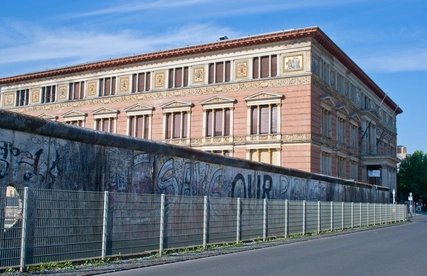
The division of Germany, the "imprisonment" of an entire nation, the centre of the Cold War - there is hardly any other building of the 20th century that has become such a symbol of lack of freedom and contempt for humanity. There is hardly any other building of the 20th century that has become such a symbol of lack of freedom and contempt for humanity as the Berlin Wall.
On 9 November, 36 years after the Peaceful Revolution that brought down the Berlin Wall, there is hardly anything left of it. The few original pieces of the Wall that are still standing are now coveted sights.
Tip: Discover Berlin with our ABOUT BERLIN app. Our multimedia city guide takes you to the places where history was made in Berlin and brings historical moments to life. Now with many new tours and highlights relating to the fall of the Berlin Wall!
Download now for free.


Tip 1: East Side Gallery

At 1.3 kilometres, the longest remaining section of the Wall is located on the Spree. The eastern side of the wall was painted by 118 artists from 21 countries, hence the name of the longest open-air gallery in the world. Among other things, you can see Honecker and Brezhnev at the Socialist Brotherly Kiss, a mural by Dimitrji Vrubel. Birgit Kinders painted the Trabi breaking through the wall.
Where: East Side Gallery, Mühlenstraße 3-100, Friedrichshain
More information about the East Side Gallery
Tip 2: Bösebrücke
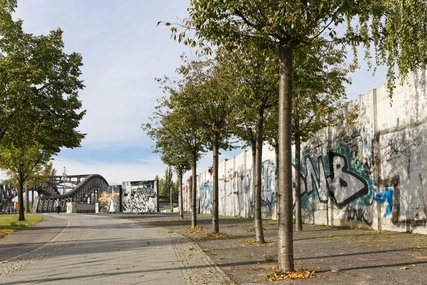
The Bornholmer Straße border crossing, at the eastern end of the bridge, was the first point of entry on the evening of 9 November 1989. November 1989 was the first place where the Berlin Wall was opened. Along Bornholmer Straße to the north is a wasteland lined by the former Hinterland security wall and allotment garden colonies. More than 100 ornamental cherry trees line the wall path here. They were a gift from the Japanese population in 1990 as an expression of their great sympathy for the reunified Germany.
Where: Bösebrücke, Bornholmer Straße 70, Prenzlauer Berg
More information on the night of the fall of the Wall
Tip: ABOUT BERLIN - Your digital city guide: Download now for free!
The Bösebrücke is a perfect starting point for cycling along the Wall Cycle Path. This is also where the cycle tour that we have put together for you in our ABOUT BERLIN app begins. Follow the route from Bösebrücke via Bernauer Straße and Checkpoint Charlie to the East Side Gallery - and learn exciting stories about the Wall and the once divided city along the way.
Use it on site in Berlin or discover the capital virtually: ABOUT BERLIN is your personal city guide with lots of insider information!


There's a lot to tell: ABOUT BERLIN
Tip 3: Checkpoint Charlie

The Americans controlled three border crossings in Berlin. Probably the best known is Checkpoint Charlie, named after the third letter of the International Spelling Alphabet (Alpha, Bravo, Charlie, ...). A last original remnant of the Wall is located not far from the Mauermuseum on the corner of Schützenstraße and Friedrichstraße.
Where: Checkpoint Charlie, Friedrichstraße 43-45, Mitte
More information about Checkpoint Charlie
Tip 4: Berlin Wall Memorial
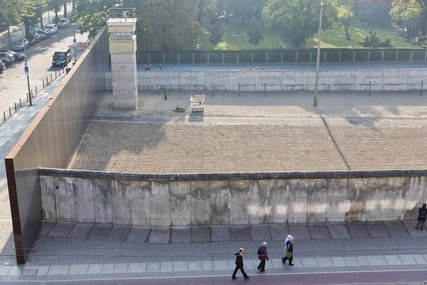
During the time of the inner-German division, the Berlin Wall ran the entire length of the southern side of Bernauer Strasse. Part of this former border strip, including the associated watchtower, is now an open-air exhibition. There is historical audio and visual material as well as a visitor centre with films and a viewing tower.
Where: Berlin Wall Memorial, Bernauer Straße 111, Mitte
More information about the Berlin Wall Memorial
Tip 5: Old Cathedral Cemetery

An approximately 15 metres long section of the front border wall and a wall made of concrete slabs, also used to secure the border, can be seen at Berlin's oldest Catholic cemetery. The section of wall is located at the northern end of the cemetery grounds, as an extension of the Liesenbrücken bridges, and is now a listed building.
Where: Alter Domfriedhof St.-Hedwig, Liesenstraße 8, Mitte
Find out more about St. Hedwig's Cathedral. Hedwig's Cathedral
Tip 6: Groß Glienicke Estate Park
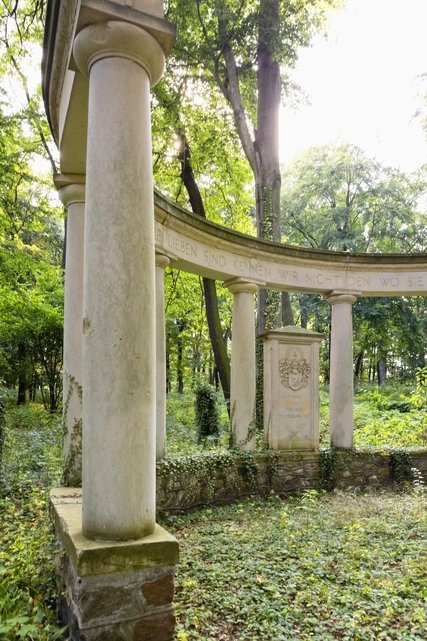
Lake Groß-Glienicke is a popular swimming area in Berlin thanks to its crystal-clear water. During the German-German division, however, this pleasure was only reserved for West Berliners: The border between West and East ran through the centre of the lake and was marked by buoys. The Berlin Wall ran along the shore. You can see what's left of it in the park.
Where: Groß Glienicke Estate Park, Potsdamer Chaussee, Potsdam
Find out more about Groß Glienicke Estate Park
Tip 7: Invalidenfriedhof
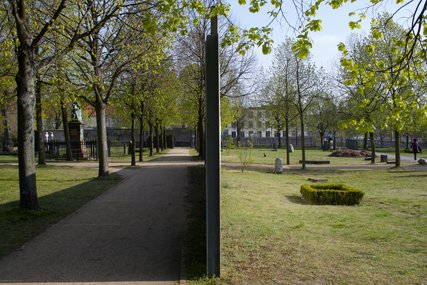
The border security of the GDR demanded more and more space and the Invalidenfriedhof was taken up more and more. In total, more than 90 per cent of the graves had to make way for the death strip with its guard towers, control strips, the running facility for the guard dogs and the column path. Some segments of the Hinterlandsicherungsmauer (hinterland defence wall) and the Kolonnenweg (column path) are still reminders of the recent past.
Where: Invalidenfriedhof, Scharnhorststraße 31, Mitte
More information about the Mauerradweg
Tip 8: Berlin Wall Park

Today's Mauerpark is located on the former death strip. The remaining remnants of the Hinterland Security Wall are a favourite subject for graffiti artists. An ordinary Sunday in Mauerpark looks like this: Stroll through the flea market and then sing along to the open-air karaoke.
Where: Mauerpark, Bernauer Straße 63-64, Mitte
More information about Mauerpark
Tip 9: Puschkinallee/ Schlesischer Busch
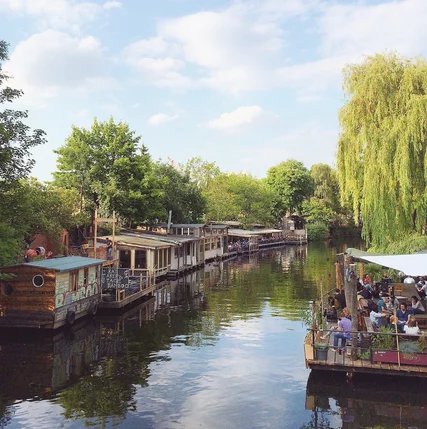
Parallel to the Flutgraben once ran the GDR's border fortifications. The former border strip between Treptow and Kreuzberg has been turned into a green area along the length of the Flutgraben. A few metres of the rear security wall have been preserved and were painted after the fall of the Wall. The "Schlesischer Busch command post" watchtower is also still standing and is now used for changing exhibitions.
Where: Puschkinalle, Lohmühlenstraße 1, Treptow
Find out more about where the Wall stood
Tip 10: Potsdamer Platz

The last original Wall segments at Potsdamer Platz (Stresemannstraße) were demolished in 2008. Six sections were subsequently erected in front of the entrance area of the station Potsdamer Platz. Just around the corner in Erna-Berger-Straße is one of the last watchtowers in Berlin, but now covered up due to renovation work on the site.
Where: Potsdamer Platz, Mitte
Find out more about the watchtower
Tip 11: Topography of Terror
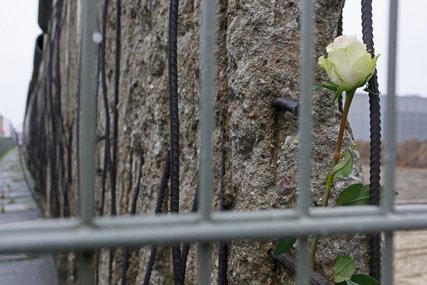
About 200 metres long, Niederkirchnerstraße marked the border between Berlin-Mitte (East Berlin) and Kreuzberg (West Berlin) until 1989. Today, the permanent exhibition Topography of Terror, a site where the most important facilities of the National Socialist persecution and terror apparatus were located between 1933 and 1945, is located behind this section of the Wall.
Where: Topography of Terror, Niederkirchnerstraße 8, Mitte
More information about the Topography of Terror
Plus 1: Wall memorial

A full 80 metres of forgotten Wall remains have been discovered in Reinickendorf by an amateur researcher and have now been officially confirmed as remnants of the former Berlin Wall. The Wall discovery is now a listed building.
Where: Wall memorial, Provinzstraße, Reinickendorf





